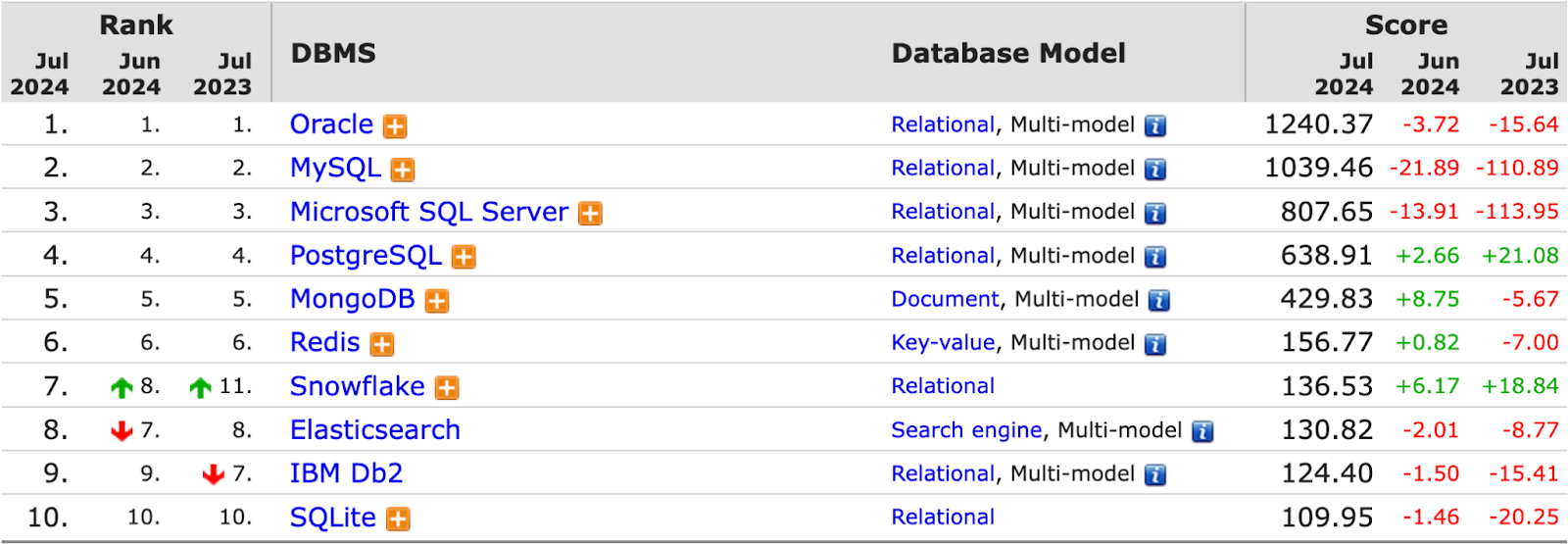Cours
Not all databases are equal. The choice of database determines how quickly and accurately you can store, retrieve, and process information, especially as your projects grow in scale and complexity.
In this blog post, I’ll focus on PostgreSQL and explain what it is and when it’s best to use it in your projects.
What Is PostgreSQL
PostgreSQL, often simply called "Postgres," is an advanced, open-source object-relational database management system (ORDBMS).
For data scientists, understanding the relational concepts at PostgreSQL's core is essential. At its simplest, PostgreSQL, much like other relational databases, organizes data into tables, where each table consists of rows (individual records) and columns (attributes or fields). These tables can be linked through keys, allowing for complex data relationships and efficient querying.
While primarily a relational database, PostgreSQL goes beyond traditional relational models by incorporating object-oriented features.
Object-oriented features are capabilities that allow PostgreSQL to manage data with more complexity and flexibility. Some of the most used and important capabilities are:
- Custom data types: Users can define their own data types, allowing for more precise and complex data structures tailored to specific application needs.
- Table inheritance: Tables can inherit properties from other tables, facilitating the reuse of table structures and simplifying the management of hierarchical data.
- Functions and procedures: PostgreSQL supports the creation of functions and stored procedures, which can be written in various programming languages, enhancing the database's ability to handle complex operations.
- JSON support: Extensive support for JSON data types allows PostgreSQL to handle semi-structured data effectively, bridging the gap between relational and document-oriented databases.
- Full-text search: PostgreSQL offers robust full-text search capabilities, enabling efficient search operations on textual data.
What Is PostgreSQL Used for
PostgreSQL serves as a versatile database management system for various applications (AI and otherwise). Key functionalities that make PostgreSQL invaluable, specifically for data scientists, are:
- Data storage and management: PostgreSQL efficiently handles large datasets for machine learning projects, statistical analyses, and data warehousing.
- Querying: Complex data retrieval is made possible through advanced SQL queries, including joins, subqueries, and window functions.
- Complex data manipulation: Its advanced SQL capabilities allow for sophisticated data transformation and preparation tasks essential in the data science workflow.
- Advanced analytics: PostgreSQL supports user-defined functions, stored procedures, and triggers, enabling complex analytical operations directly within the database.
Why Choose PostgreSQL? A Data Scientist's Perspective
Let's take a closer look at the specific advantages that PostgreSQL offers to data scientists, starting with its open-source nature.
Open-source
As an open-source solution, PostgreSQL offers significant cost savings compared to proprietary expensive databases. Being open-source, it benefits from an active community that continually enhances product capabilities and provides support.
Feature-rich
PostgreSQL provides a comprehensive set of tools for data manipulation and analysis. Its support for window functions, common table expressions (CTEs), and advanced aggregations empowers data scientists to perform complex analyses efficiently.
Advanced functionalities
PostgreSQL's advanced features set it apart:
- Functions: Create custom routines for complex calculations or data transformations.
- Triggers: Automate responses to database events, ensuring data consistency.
- Views: Simplify complex queries and provide abstraction layers for your data.
These features allow data scientists to implement sophisticated data processing logic directly within the database, often improving performance and maintainability.
Data integrity and quality
PostgreSQL ensures high levels of data integrity and quality through its robust typing system and support for ACID (Atomicity, Consistency, Isolation, Durability) transactions.
But what exactly is ACID, and why is it essential?
ACID transactions are a set of properties that guarantee reliable processing of database transactions. They ensure that data remains accurate and secure even in the face of errors, crashes, or concurrent access. These properties are vital for maintaining data quality in any project.
- Atomicity: Ensures all parts of a transaction are completed successfully or none are, maintaining data integrity.
- Consistency: Guarantees transactions always leave the database in a valid state, ensuring data accuracy.
- Isolation: Ensures concurrent transactions don't interfere with each other, maintaining data correctness.
- Durability: Guarantees committed transactions are permanent, even in the event of a system failure, ensuring data persistence.
These ACID properties are crucial for maintaining the high data quality and reliability required for successful data-driven projects.
Support for Python
One of the key advantages of PostgreSQL for data scientists is its excellent support for Python, a language widely used in data science and machine learning. PostgreSQL can be easily integrated with Python using libraries such as psycopg2 and SQLAlchemy. This integration allows data scientists to seamlessly connect to PostgreSQL databases, execute queries, and manipulate data directly from their Python scripts. The ability to use Python with PostgreSQL enhances productivity and enables the faster development of data processing pipelines and machine learning workflows.
PostgreSQL vs. the Competition
While PostgreSQL excels in many areas, it's essential to understand how it compares to other popular database options:
|
Database |
Type |
Key Features |
Strengths |
Common Use Cases |
|
PostgreSQL |
Open-source |
Extensive features, scalability, customizability |
Cost-effective, flexible, strong community |
Large datasets, complex queries, data science projects |
|
Oracle |
Commercial |
Robust security, advanced analytics, high availability |
Enterprise-grade, reliable, scalable |
Large-scale applications, high-security environments |
|
Open-source |
Speed, simplicity, ease of use |
Fast, popular for web applications |
Web development, dynamic content, high-traffic websites |
|
|
Commercial |
Integration with Microsoft products, comprehensive tools |
Robust for Windows environments, strong BI tools |
Enterprise applications, data warehousing, business analytics |
|
|
Serverless |
Lightweight, simple, minimal setup |
Embedded, portable, fast |
Mobile and desktop apps, small-scale projects |
These databases have unique strengths, making them suitable for different use cases. Understanding their features and capabilities can help you choose the best option for your specific data management needs.
DB-Engines DBMS ranking
The following ranking table is sourced from DB-Engines, a renowned platform that tracks the popularity of various DBMS options.
DB-Engines evaluates databases based on several factors, including search engine results, technical discussions, job offers, and social media mentions, providing a holistic view of their current standing in the market.
As of July 2024, PostgreSQL was in the fourth position:

PostgreSQL strengths against competitors
PostgreSQL has several advantages over its competitors. Let's start by examining its scalability.
Scalability
PostgreSQL shines when it comes to handling large datasets. Its ability to efficiently manage terabytes of data makes it suitable for big data applications. With features like table partitioning, parallel query execution, and support for multiple indexing methods, PostgreSQL ensures high performance and responsiveness, even as the data volume grows.
Extensibility
One of PostgreSQL's most notable strengths is its extensibility. Users can add new data types, operators, index types, and even procedural languages. This flexibility allows PostgreSQL to be customized to meet specific application needs.
Community and Support
As an open-source project with a large and active community, PostgreSQL benefits from continuous improvements and a wealth of shared knowledge. Users have access to a plethora of free resources, including documentation, forums, and third-party tools, making it easier to find solutions and implement best practices.
Cost
Being open-source, PostgreSQL eliminates the need for expensive licensing fees, making it an attractive option for startups and enterprises looking to optimize their budget without compromising on features and performance.
PostgreSQL's disadvantages
While PostgreSQL offers numerous advantages, it's important to consider its potential drawbacks as well.
Learning curve
PostgreSQL's wide array of features can present a steeper learning curve compared to simpler databases like SQLite. New users may need to invest time in understanding its advanced concepts to fully leverage its capabilities.
Resource requirements
For very large datasets or high-concurrency scenarios, PostgreSQL may demand more system resources compared to lightweight alternatives like SQLite. Proper configuration and optimization become crucial for optimal performance in these cases.
Is PostgreSQL Right for You?
When deciding whether to use PostgreSQL for your data science projects, consider the following:
- Data complexity: If your project involves complex relationships or advanced querying needs, PostgreSQL's robust features make it an excellent choice.
- Scalability: For projects expected to grow significantly, PostgreSQL's ability to handle large datasets is a major advantage.
- Advanced analytics: If you need to perform complex calculations or data transformations within the database, PostgreSQL's extensibility is invaluable.
- Data integrity: For projects where data accuracy and consistency are critical, PostgreSQL's ACID compliance provides peace of mind.
PostgreSQL may be overkill for small projects or those with very specific, lightweight database needs. However, for most data science applications, its power and flexibility make it a strong contender.
Learn PostgreSQL
To start your PostgreSQL journey, consider the following learning resources:
- Official documentation: The PostgreSQL website offers comprehensive, free documentation covering all aspects of the system.
- Creating PostgreSQL Databases course: DataCamp provides a free course on Creating PostgreSQL Databases. You can learn how to create a PostgreSQL database and explore the structure, data types, and how to normalize databases in just a few hours.
- PostgreSQL tutorial: A free online resource with hands-on examples and practical exercises.
- PostgreSQL user groups: Join local or online communities to learn from experienced users and stay updated on best practices.
Conclusion
PostgreSQL is one of the most popular relational databases. Its robust feature set, scalability, and strong data integrity make it an excellent choice for a wide range of projects. While it may require some initial investment in learning, the benefits it offers in terms of data management, advanced analytics, and overall project flexibility are substantial.
Whether you're working on machine learning models, statistical analyses, or large-scale data processing, PostgreSQL provides a solid foundation for your data infrastructure.
If you need a PostgreSQL certification, check out this blog on PostgreSQL Certification: Everything You Need to Know.
FAQs
How do I download PostgreSQL?
Visit the official PostgreSQL website (postgresql.org) and navigate to the download section. Choose the appropriate version for your operating system.
Can I install PostgreSQL on my operating system?
Yes, PostgreSQL supports all major operating systems including Windows, macOS, and various Linux distributions.
Can I use PostgreSQL in the cloud?
Yes—many cloud providers offer managed PostgreSQL services, including Amazon RDS, Google Cloud SQL, and Azure Database for PostgreSQL.
Can I connect to PostgreSQL from Python?
Yes, you can connect to PostgreSQL from Python using libraries like psycopg2 or SQLAlchemy.

